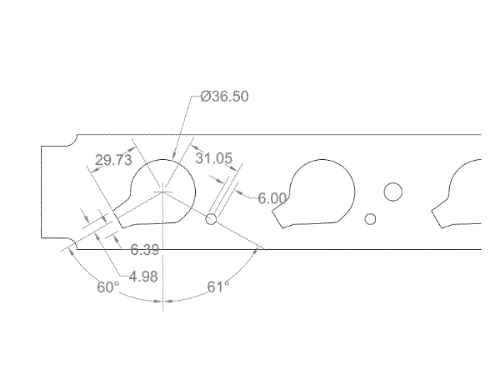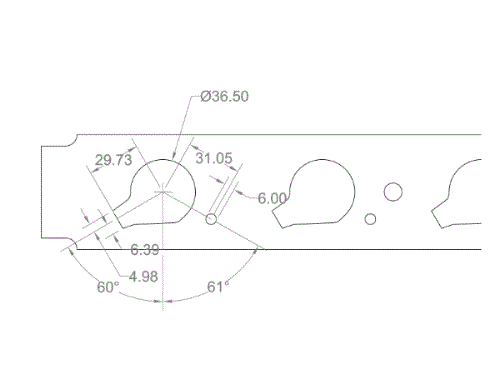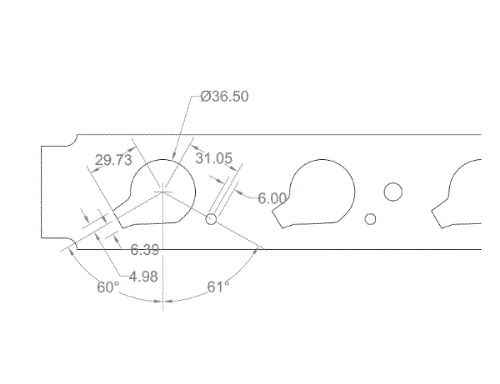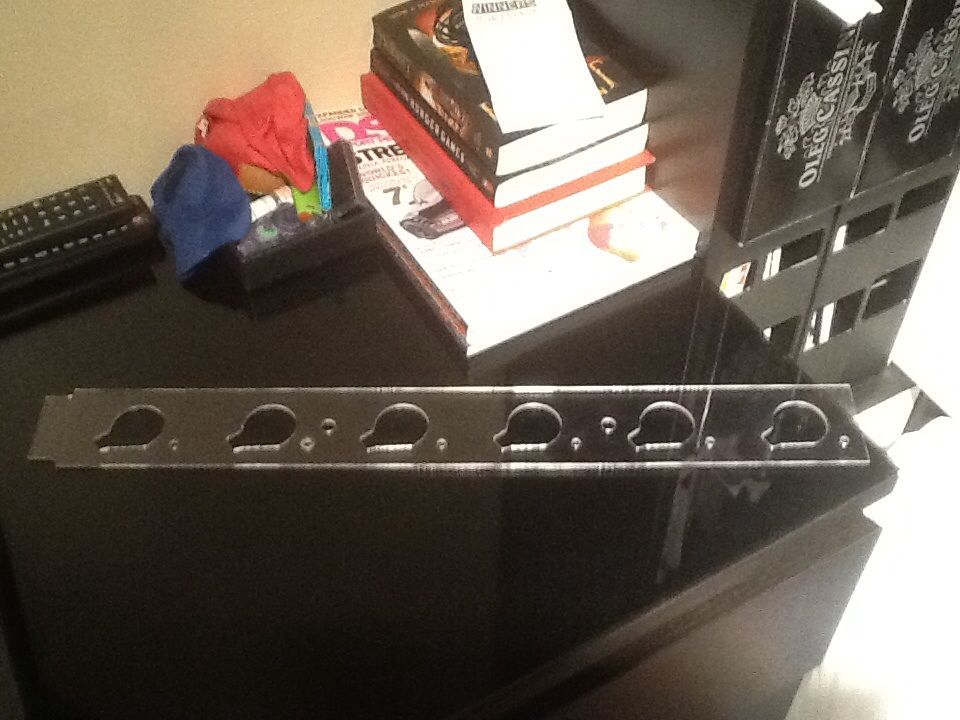morganson's COP S-Type setup
- Thread starter morganson
- Start date
You are using an out of date browser. It may not display this or other websites correctly.
You should upgrade or use an alternative browser.
You should upgrade or use an alternative browser.
1986.5supra_kid;1979130 said:so 1/4 thick. Supraguy@aol if you have any coils i try getting one made.
the hard part will be making the coil outline. some measurments would be good
I didn't forget about this. I was hoping to have the test piece made before giving you these last dimensions.
Unfortunately my old shop has been super busy (thought I would have this thing in a couple days not weeks) but they said they would run it by Monday at the latest.
Until then, here are the dimensions I used.

I cannot tell you guts how happy it makes me to see so much support for this. Thank you guys so much!
Aesthetically the stock coils have always been a sore spot for me. The IS300 coils are a nice alternative but I feel this setup has a classic look about it.
That being said, I'm looking forward to Grim's compairison. I want to make sure they are going to work properly even though they will be going on my little GE (will have to swap to turbo electronics to do this).
That being said, I'm looking forward to Grim's compairison. I want to make sure they are going to work properly even though they will be going on my little GE (will have to swap to turbo electronics to do this).
Last edited:
1986.5supra_kid
Rice? No its Corn (E85)
Excellent!!AbsoluteSpeed;1981273 said:I didn't forget about this. I was hoping to have the test piece made before giving you these last dimensions.
Unfortunately my old shop has been super busy (thought I would have this thing in a couple days not weeks) but they said they would run it by Monday at the latest.
Until then, here are the dimensions I used.

AbsoluteSpeed;1981273 said:I didn't forget about this. I was hoping to have the test piece made before giving you these last dimensions.
Unfortunately my old shop has been super busy (thought I would have this thing in a couple days not weeks) but they said they would run it by Monday at the latest.
Until then, here are the dimensions I used.

Can you send me that file please. Everytime I try to save it my browser crashes.
morganson;1981607 said:Can you send me that file please. Everytime I try to save it my browser crashes.
Odd. I resaved it and sent it to you.
1986.5supra_kid
Rice? No its Corn (E85)
Took long enough. My old shop finally got this done after they forced me to eat and drink with them..

Now I just need to find the old coil out of my truck and test fit it. A 2000 F150 coil is the same, right?

Now I just need to find the old coil out of my truck and test fit it. A 2000 F150 coil is the same, right?
AbsoluteSpeed;1981816 said:Took long enough. My old shop finally got this done after they forced me to eat and drink with them..

Now I just need to find the old coil out of my truck and test fit it. A 2000 F150 coil is the same, right?
awesome! how much did they charge you to cut it out?
$0
It is only a plastic template to make sure they fit properly. They can make the actual part but will make me pay for the router bit (it's a plastic company and they don't want to ruin the bits on aluminum). Also, shipping might be expensive for you folks in the states.
It is only a plastic template to make sure they fit properly. They can make the actual part but will make me pay for the router bit (it's a plastic company and they don't want to ruin the bits on aluminum). Also, shipping might be expensive for you folks in the states.
Lookd great. As long as it works we know the measurments are right.
Yes the two bodies are the same though the plug is a little different.
Yes the two bodies are the same though the plug is a little different.
just stubled accross this im taking a few ds500 home from work today gonna mock up on my spare 2jzge head. gonna be using on 2jzge on 7m electronics gonna have a FFIM in the spring and gte valve covers hopefully they clear under the center spark plug cover. ill keep you all posted with photos.
thanks
justin
thanks
justin
Just a question. How well would that plastic hold up to heat? I know everyone likes aluminum but plastic is a lot cheaper.
I'm glad to see that you got some progress, A.S.
I think the plates could be shipped for a decent price, if they were simply dropped into a 24" cardboard tube.
I Don't think that plexi would hold up too well to the heat. Aluminum or carbon fiber is the way to go.
I think the plates could be shipped for a decent price, if they were simply dropped into a 24" cardboard tube.
I Don't think that plexi would hold up too well to the heat. Aluminum or carbon fiber is the way to go.
I could see carbon fiber getting expensive. Unless you can do it yourself. I guess aluminum would be the way to go
I need to organize the scope images a bit before posting them. Way to many measurements that can be shown off one image. Makes it a cluster to see things.
The short story is this. Im almost certain the ignitor performs current sensing. A block of dwell time is provided that should allow the coil to fully charge, then current limiting takes place until the ignition event is triggered. The times listed below are from coil shorting (begin to charge) until current limiting takes place.
Stock 2.96-3.16ms
IS300: 3.16-3.2ms
Ford: 4ms+ (2 coils wired in series)
The ford coils do not reach the current limiting state at any rpm except idle. The ignitor appears to calculate a dwell window based off rpm, all calculated internally. This window has always been 3ms+ even as rpms increase. What you see on the scope is that the dwell window may 'shrink' a bit, but the coil has enough time to charge to current limiting state. Usually this window is 3.5ms-4ms as rpms increase.
At 6500rpm, the ignitor has 9.231ms per 360degrees of crank rotation. Coil for 1/6 fires every 9.231ms. Plenty of time and duty cycle left over to allow things to cool on the coil side. The stock coils need about 1-2ms to recover after a firing event, judged by the burn duration and oscillations. This varies a bit though.
The stock coils appear to be CDI coils with out a capacitor. Very low resistance. The Is300 coils are 0.6-0.5 ohms, stock 0.4-0.3ohms, ford 1.0-0.9ohms.
Installing a sense resistor to test the current ramp of each coil tonight. I believe the ford coils may be reaching a sufficient charge, although not the current the ignitor expects to see. Even if these are wired in parallel, the current limiting of the ignitor will prevent additional charge.
Once the ignitiors current limiting value is known, it should be easier to plan what will work best going forward.
The short story is this. Im almost certain the ignitor performs current sensing. A block of dwell time is provided that should allow the coil to fully charge, then current limiting takes place until the ignition event is triggered. The times listed below are from coil shorting (begin to charge) until current limiting takes place.
Stock 2.96-3.16ms
IS300: 3.16-3.2ms
Ford: 4ms+ (2 coils wired in series)
The ford coils do not reach the current limiting state at any rpm except idle. The ignitor appears to calculate a dwell window based off rpm, all calculated internally. This window has always been 3ms+ even as rpms increase. What you see on the scope is that the dwell window may 'shrink' a bit, but the coil has enough time to charge to current limiting state. Usually this window is 3.5ms-4ms as rpms increase.
At 6500rpm, the ignitor has 9.231ms per 360degrees of crank rotation. Coil for 1/6 fires every 9.231ms. Plenty of time and duty cycle left over to allow things to cool on the coil side. The stock coils need about 1-2ms to recover after a firing event, judged by the burn duration and oscillations. This varies a bit though.
The stock coils appear to be CDI coils with out a capacitor. Very low resistance. The Is300 coils are 0.6-0.5 ohms, stock 0.4-0.3ohms, ford 1.0-0.9ohms.
Installing a sense resistor to test the current ramp of each coil tonight. I believe the ford coils may be reaching a sufficient charge, although not the current the ignitor expects to see. Even if these are wired in parallel, the current limiting of the ignitor will prevent additional charge.
Once the ignitiors current limiting value is known, it should be easier to plan what will work best going forward.
I may have someone who could cut some plates out for me, he's going to talk to his machinist buddy.
How much would you guys pay forjust a plate? Trying to get a ballpark range for him to see if it is even worth cutting a big amount.
Which material would you like to see ? Steel, aluminum? Maybe even a carbon fiber plate
Sent from my PC36100 using Tapatalk 2
How much would you guys pay forjust a plate? Trying to get a ballpark range for him to see if it is even worth cutting a big amount.
Which material would you like to see ? Steel, aluminum? Maybe even a carbon fiber plate
Sent from my PC36100 using Tapatalk 2
